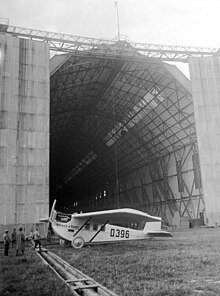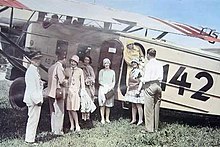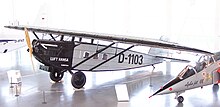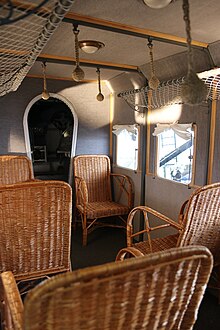Dornier Komet
| Komet, Merkur, and related | |
|---|---|

| |
| Komet III | |
| Role | Airliner |
| Manufacturer | Dornier Flugzeugwerke |
| First flight | 1921 |
| Developed from | Dornier Delphin |
| Variants | Dornier Do 10 |
The Dornier Komet (Comet), Merkur (Mercury), Do C, Do D, and Do T were a family of aircraft manufactured in Germany during the 1920s, originally as small airliners, but which saw military use as well. The earliest aircraft in the series were basically landplane versions of the Delphin flying boat, and although the Delphin and Komet/Merkur series diverged from each other, design changes and refinements from one family were often incorporated into the other. All variants were braced high-winged single-engine monoplanes with conventional landing gear.
Design and development



The first Komets (Do C III Komet I) utilised the same rectangular plan, 17 m (55 ft 9 in) span wing, tail, and even upper fuselage, as well as the 138 kW (185 hp)
The Do Komet III of 1924 was a practically all-new design that shared many elements with the Delphin III. The cabin was expanded to seat another two passengers and the larger wing, with a span of 19.6 m (64 ft 4 in), was raised above the fuselage on short struts. Power was greatly increased from the Komet I, with a 340 kW (450 hp) Napier Lion engine.[3] This version was exported to Denmark and Sweden, but was also produced under licence in Japan by Kawasaki.
In 1925, the Komet III was replaced in production by the Do B Merkur I, which featured a revised fin and longer-span wings. When fitted with the BMW VI engine, it became known as the Do B Bal Merkur II, as did indeed any Komets thus re-engined. The type was widely used by Deutsche Luft Hansa, which had some 30 Merkurs operating at one time, and was also exported to Brazil, China, Colombia, Japan, and Switzerland.
The Do C and Do D were follow-on military designs, the former a trainer exported to
A replica Dornier Merkur was made for the Dorner Museum in the early 2000s.
Variants


- First of the Komet series
- Do Komet II
- Do Komet III
- larger, more powerful four-six passenger version.[3]
- Do B Merkur I
- Do B Bal Merkur II
- Do C
- Military version of the Komet III
- Do C-1: Two-seat fighter.
- Do C-2A: Recognition version.
- Do C-3: Recognition version.
- Do C-4: Do-10, development of C-1.
- Do D
- A much revised floatplane torpedo bomber version for the Royal Yugoslav Air Force
- Do T
- An ambulance version
Operators
Civil operators


- Ukrvozdukhput[7]
Military operators
- Colombian Air Force
- Yugoslav Royal Navy
Specifications (Merkur II)





Data from European Transport Aircraft since 1910[8]
General characteristics
- Crew: one
- Capacity: eight passengers
- Length: 12.5 m (41 ft 0 in)
- Wingspan: 19.6 m (64 ft 4 in)
- Height: 3.56 m (11 ft 8 in) [9]
- Wing area: 62.0 m2 (667 sq ft)
- Empty weight: 2,100 kg (4,630 lb)
- Gross weight: 3,600 kg (7,937 lb)
- Powerplant: 1 × V-12 engine, 450 kW (600 hp)
Performance
- Maximum speed: 200 km/h (120 mph, 110 kn)
- Cruise speed: 180 km/h (110 mph, 97 kn)
- Range: 750 km (466 mi, 405 nmi) [10]
- Service ceiling: 5,200 m (17,100 ft)
References
- ^ "Les avions Dornier". Les Ailes (8): 2. 11 August 1921.
- ^ "A New German All-Metal Machine". Flight. XIII (13): 223–224. 31 March 1921.
- ^ a b Serryer, J (19 February 1925). "L'Avion Dornier "Komet" III". Les Ailes (192): 2.
- ^ a b c Hooks Aeroplane June 2016, p. 52.
- ^ a b Hooks Aeroplane June 2016, p. 51.
- ^ Hooks Aeroplane June 2016, pp. 52–53.
- ^ Hooks Aeroplane June 2016, pp. 51–52.
- ^ Stroud 1966, p. 246.
- ^ Donald 1995, p. 347.
- ^ Stroud Aeroplane Monthly January 1984, p. 39.
Bibliography
- Cooksley, Peter (September–October 1996). "Celestial Coaches: Dornier's Record Breaking Komet and Merkur". Air Enthusiast (65): 20–24. ISSN 0143-5450.
- Donald, David, ed. (1997). The Encyclopedia of World Aircraft. Leicester, UK: Blitz Editions. ISBN 1-85605-375-X.
- Hooks, Mike (June 2016). "Dornier Rising". ISSN 0143-7240.
- Isaic, Vladimir (March–April 1999). "Yugoslav Naval Strike: Dornier's Merkur Seaplane in the Military Role". Air Enthusiast (80): 72–75. ISSN 0143-5450.
- Ledet, Michel (April 1993). "L'aéronautique naval yugoslave des années 20 à Avril 1941" [Yugoslav Naval Aviation from the Twenties to April 1941]. Avions: Toute l'aéronautique et son histoire (in French) (2): 2–12. ISSN 1243-8650.
- Nikolic, Djordie & Ognjevic, Akeksandar M. (2021). Dornier: The Yugoslav Saga 1926-2007. Lublin, Poland: Kagero Publishing. ISBN 978-83-66673-61-8.
- Stroud, John (1966). European Transport Aircraft since 1910. London: Putnam.
- Stroud, John (January 1984). "Wings of Peace—Part 4: Dornier Komet and Merkur". ISSN 0143-7240.
- Tassell, Roy (May–June 1999). "Round-Out". Air Enthusiast (81): 78. ISSN 0143-5450.
- Zuerl, Walter (1941). Deutsche Flugzeug Konstrukteure. München, Germany: Curt Pechstein Verlag.
Further reading
- Taylor, Michael J. H. (1989). Jane's Encyclopedia of Aviation. London: Studio Editions. p. 327.
- World Aircraft Information Files. London: Bright Star Publishing. pp. File 892 Sheet 26.
External links
- German aircraft between 1919 and 1945 Archived 30 October 2013 at the Wayback Machine
